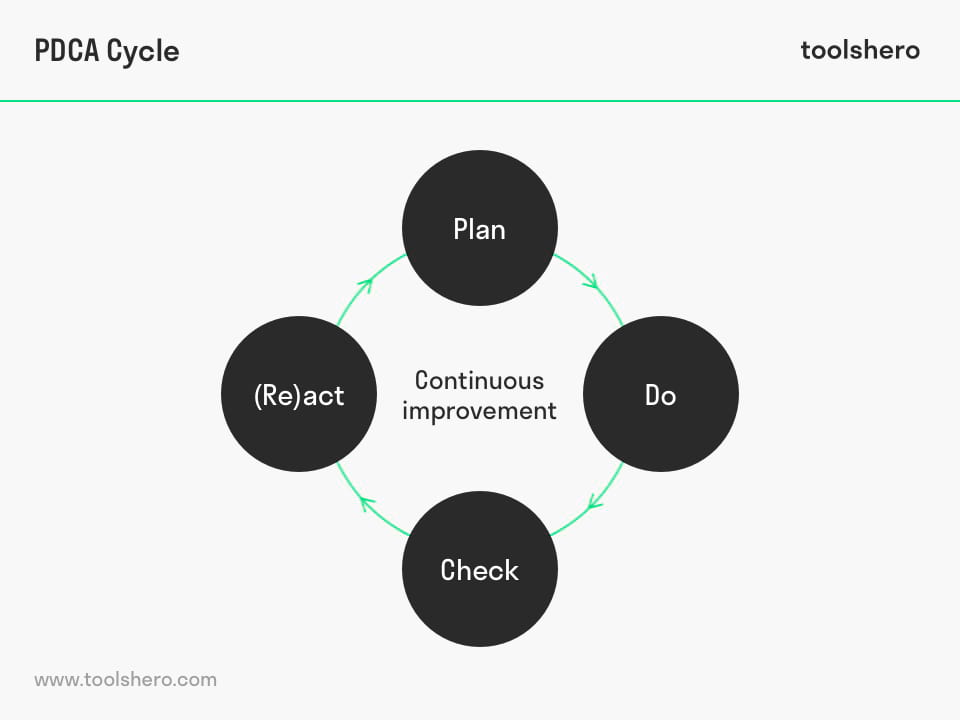Deming PDCA Cycle: meaning and principles

Deming PDCA Cycle: this article explains the Deming PDCA Cycle further developed by William Edwards Deming in a practical way. After reading you will understand the meaning, how do you apply it including principles of this powerful problem solving approach. Enjoy reading this article.
What is PDCA cycle?
History and goal
In process-oriented work, organizations will always aim at results. But how can organizations aim at achieving the desired results? The original founder of the PDCA cycle is Walter Andrew Shewhart (1939). William Edwards Deming further developed the PCDA cycle in the 1950 to help organisations achieve better results.
Meaning
This so-called Deming Cycle is a means of control to monitor the quality of changes and improvements within the organization.
The PDCA cycle stands for the abbreviation of the four main steps in the cycle: Plan, Do, Check and (Re) Act.
PDCA cycle is PDCA circle
The PDCA model is based on the scientific method of proposing a change in a process and has a cyclic character, which safeguards continuous attention to quality improvement.
After evaluation and possible adjustment, the process is restarted. The model is often used at an organisational level, but can also be used at an operational level.
The PDCA cycle is an iterative four-step problem-solving technique that allows employees to evaluate their own work method and improve it where necessary. Because everyone on the workfloor is part of the total process, this positively impacts the entire organisation.
The PDCA cycle is also known as the Shewhart Cycle.
Where is the PDCA cycle applied?
The PDCA model is a helpful tool for varying matters within an organisation. The cycle is applied to a large number of situations. The PDCA cycle is most effective when applied to the following matters:
- Exploring and testing changes at a process level within the organisation
- Preventing and adjusting ineffective solutions before changes can be implemented within the entire organisation
- The continuous improvement of Total Quality Management (TQM)
- The continuous improvement of Six Sigma solutions
The most important advantage of the PDCA cycle is that it can be applied to various different industries and organisation types.
How do you apply the PDCA cycle? The principles
The different steps within the PDCA cycle can be viewed as separate sub-processes in complex processes.

Figure 1 – PDCA Cycle model (Shewhart & Deming)
In simple processes, the steps and principles are aimed at separate activities:
Plan
This step focuses on the improvement of activities. What is the desired output/ situation (Soll), and how do people seek to achieve that. It is important to create good SMART Goals beforehand, that are agreed upon by all stakeholders. Additionally, the available resources must be analysed beforehand.
Everything that needs to be done is planned in this stage. Depending on the size of the organisation or the project, a large portion of the resources, such as time, may be allocated to the team efforts in making this plan possible.
Developing the plan usually consists of several steps, and ensures that there are as few deviations as possible during the project.
Before moving to the next phase, it’s important that several essential questions have been answered:
- What are problems we may face during the project?
- What resources do we need?
- What resources are available?
- What are the requirements and wishes of the different stakeholders?
- What conditions have been set for the project?
- What are the project SMART goals?
Do
This concerns the execution and realisation of the planned improvements of the entire process. During the execution, the output is continuously measured and registered and relevant information is gathered.
In this stage, it’s time to take action. The plan has been established, discussed, distributed and checked, and everything that was decided in the previous phase is now applied. Take into account that, despite good planning, unexpected problems may occur. For this reason, it is advisable to first implement major changes in a controlled, more compact environment.
Standardisation ensures that the plan’s application goes smoothly. Make sure everyone within the team and the organisation knows his or her roles and responsibilities.
After controlled implementation, the changes can be implemented on a larger scale. In this phase of the model, the problem is actively solved, particularly by putting the right people in the right place with the right knowledge and resources.
Check
In this check phase, the results of the improvement are measured and compared to the desired situation. In case of large differences (‘planning gaps’), it is important to respond quickly and track down the cause of possible differences.
Checking the results is probably the most important phase of the PDCA cycle. Sufficient attention must be paid to make sure recurring mistakes are avoided and continuous improvement in relation to the business processes takes place.
This phase is characterised by active checking and evaluation of the effectiveness of the original plan. Moreover, during this phase, the project team can identify problem areas of the project and eliminate or improve these in the future.
- Check whether the standard is being adhered to and whether the team is sticking to the original plan
- Look at what works, what is effective, and what is less effective or problematic in the execution of the project
- With every step, ask: why does this work? And: why doesn’t this work?
- Improve the business processes
(Re)Act
After detection of result differences, it’s important to react and adjust. Measures are taken to achieve the originally planned result.
The fourth and final phase concerns adjustments. In the last three steps, the plan was developed, applied and checked. Now it’s time to act and correct the course. If everything goes according to plan and the results are satisfactory, there’s no need to deviate from the current course.
However, this is usually needed. If the objectives are achieved, the plan has been approved. It’s important to go through the four steps of the PDCA cycle again every time a new change is made to the plan, or a completely new plan is implemented.
The Plan-Do-Check-Act cycle is simple but powerful. The framework serves to solve problems at all levels of the company. It can also be part of the full planning process at top management level.
It’s particularly the cycle’s repetitive cycle that helps the project team to find and test solutions. Finally, it’s important to emphasise that the proper application of the PDCA cycle takes time. Therefore, it is less suitable for solving important and urgent problems.
In this phase, answer the following questions:
- What options exist for implementing improvements?
- What opportunities can still be utilised?
- Is the performance measurement accurate? And how can we measure the results of solutions even more accurately?
- Is training needed to facilitate successful implementation?
- What resources do we need to implement the developed solutions with the entire organisation?
Pro-Act
In complex, directive processes, a Pro-Act phase is also included. The Pro-Act phase is a design phase that explores how a new vision and/or strategy can be developed. New possibilities to achieve good results are investigated. All gathered information can be used in the Re-Act or Plan phase.
PDCA cycle: every level
The PDCA cycle is applied within all management levels, usually unconsciously rather than consciously. The board often focuses more on the primary business processes, whereas middle management is aimed at the ensuing sub-processes. Interaction between the process itself and the eventual result is very important on each level.
First, the order flow gets going, that produces the result. Possible adjustment or intervention is only possible after evaluation. Subsequently, an order flow is started again. This continuously safeguards the quality.
Supporting Lean manufacturing tools
Due to the repetitive character of the PDCA cycle, it can be effectively combined with different Lean tools. These tools are particularly effective during the first phase:
5S principle
This tool, 5S consists of five principles: soft, set, shine, standardise, and sustain. By applying this system to the planning phase, accuracy is guaranteed.
Gemba Walk
The Gemba Walk is an excellent method for management to make the rounds in the work environment of their company and identify inefficiencies and waste on a daily basis. Important elements include asking questions and showing respect towards the employees.
Andon
Andon is a special system designed to inform managers and operators of acute problems to enable immediate corrective measures.
Poka-yoke
The Japanese Poka yoke means mistake-proofing or inadvertent error prevention. A poka yoke is a mechanism in a process that helps the operator avoid mistakes. The goal is to eliminate all defects (zero defects), or to correct or manage these when they occur. It was originally thought up by Shigeo Shingo as part of the Toyota production system.
Mapping
A business process is fully drawn up and analysed with Business Process Mapping (BPM). Because the process is visualised, inefficiencies and mistakes can be discovered sooner. Use this tool in the planning process of a project.
Swim Lane Diagram
A swim lane diagram is a kind of process flow diagram, or flowchart, that visually distinguishes the task division and responsibilities for sub-processes of a larger business process. Swim lane diagrams can be set up both horizontally and vertically.
Single-minute Exchange of Dies (SMED)
SMED is one of the many Lean production methods of reducing inefficiencies and waste in a production process. It offers a fast and accurate method for converting the process from a current situation to a next product. This fast switch is the key to reducing batch sizes and thus reducing unequal flows, production loss and variability in output of a production unit.
Pros and cons of the PDCA cycle
The PDCA cycle has several pros and cons. It’s important that the user considers these before implementing this tool in one or even multiple projects.
Pros Plan-Do-Check-Act cycle
- The PDCA cycle is very versatile. Its general character means it can be used in many different business environments. The instrument can be used for a myriad of applications. Often, it’s used in project management, change management, product development and resource planning
- Additionally, the tool is simple but powerful. The PDCA tool is very simple and easy to understand for everyone. Yet, it harbours a powerful motor that drives useful adjustments and improvements. At the same time, waste is minimised and the efficiency of different business processes is increased.
Cons Plan-Do-Check-Act cycle
- The tool itself is simple and consists of several clear steps, but accurately applying it can still be very complex. Precisely the number of steps in the model can slow down process improvement. It takes time to complete and check the different steps. This is the main reason that PDCA is not suitable for urgent problems within the organisation
- The use of PDCA demands discipline and effort. PDCA is not a one-off evaluation of a situation. It’s a continuous process that demands engagement and perserverance. This applies to organisational components throughout the entire hierarchy. Top management must ensure that sufficient resources are appointed to allow business units to utilise this tool, and managers in the lower business units must be determined to implement the changes and introduce these to the other employees.
It’s Your Turn
What do you think? How do you apply the PDCA process in your daily business? Do you recognize the practical explanation or do you have additions? What are your success factors for a good use of the PDCA cycle?
Share your experience and knowledge in the comments box below.
More information
- Bulsuk, K.G. (2009). Taking the First Step with PDCA. Available at https://www.bulsuk.com/2009/02/taking-first-step-with-pdca.html.
- Deming, W. E. (1986). Out of the Crisis. MIT Centre for Advanced Engineering Study.
- Shewhart, W. A. (1939). Statistical Method from the Viewpoint of Quality Control. Dover Publications.
- Sobek II, D. K., & Smalley, A. (2008). Understanding A3 Thinking: A Critical Component of Toyota’s PDCA Management System. Productivity Press.
How to cite this article:
Janse, B. (2020). Deming PDCA Cycle: meaning and principles. Retrieved [insert date] from Toolshero: https://www.toolshero.com/problem-solving/pdca-cycle-deming
Published on: 03/14/2020 | Last update: 10/21/2022
Add a link to this page on your website:
<a href=”https://www.toolshero.com/problem-solving/pdca-cycle-deming”>Toolshero: Deming PDCA Cycle: meaning and principles</a>












